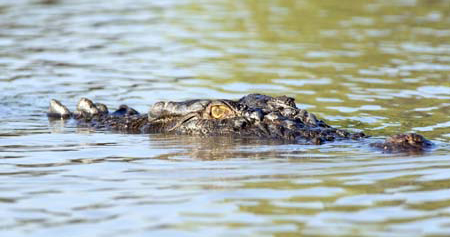Did you know

The saltwater crocodile is the largest living reptile species. It can grow up to six metres and is a serious threat to humans.
Saltwater crocodiles have evolved special characteristics that make them excellent predators.
- Large saltwater crocodiles can stay underwater for at least one hour because they can reduce their heart rate to 2-3 beats per minute. This means that crocodiles can wait underwater until they see prey, or if people are using the same spot regularly, the crocodile can wait underwater until someone approaches the water’s edge.
- A crocodile can float with only eyes and nostrils exposed, enabling it to approach prey without being detected.
- When under water, a special transparent eyelid protects the crocodile’s eye. This means that crocodiles can still see when they are completely submerged.
- The tail of a crocodile is solid muscle and a major source of power, making it a strong swimmer and able to make sudden lunges out of the water to capture prey. These strong muscles also mean that for shorts bursts of time crocodiles can move faster than humans can on land.
- Crocodiles have a thin layer of guanine crystals behind their retina. This intensifies images, allowing crocodiles to see better at low light levels.
- Crocodiles have a ‘minimum exposure’ posture in the water, which means that only their sensory organs of eyes, cranial platform, ears and nostrils remain out of the water. This means that they often go unseen by prey, but if they are observed, the prey is often not able to tell how big the crocodile is.
- Crocodile eyes are located very closely together and they are oriented forward. This enables them to judge distance very accurately so they can determine the exact location of their prey prior to attack.
- Crocodiles have excellent hearing, which helps them to locate prey particularly in poor light or low visibility conditions.
- While crocodiles may regularly lose teeth, they have a second tooth sitting in reserve underneath the external tooth, which can replace the lost tooth.
- Crocodiles can grow up to 3000 new teeth over their lifetime.
- The jaws of crocodiles are designed to generate enormous power when the jaws are closing. This enables them to quickly crush prey.
- The sex of young saltwater crocodiles is determined by the incubation temperature. Below 30oC the hatchlings will be female, and above 32oC they will be male.
- It takes females 10 to 12 years, and males 16 years and more to reach maturity.
- The saltwater crocodile is potentially long-lived, surviving to over 65.
- Saltwater crocodiles can swim at 15 to 18 mph (24 to 29 km/h) in short bursts, around three times as fast as the fastest human swimmers.
Last updated: 04 Jul 2016


